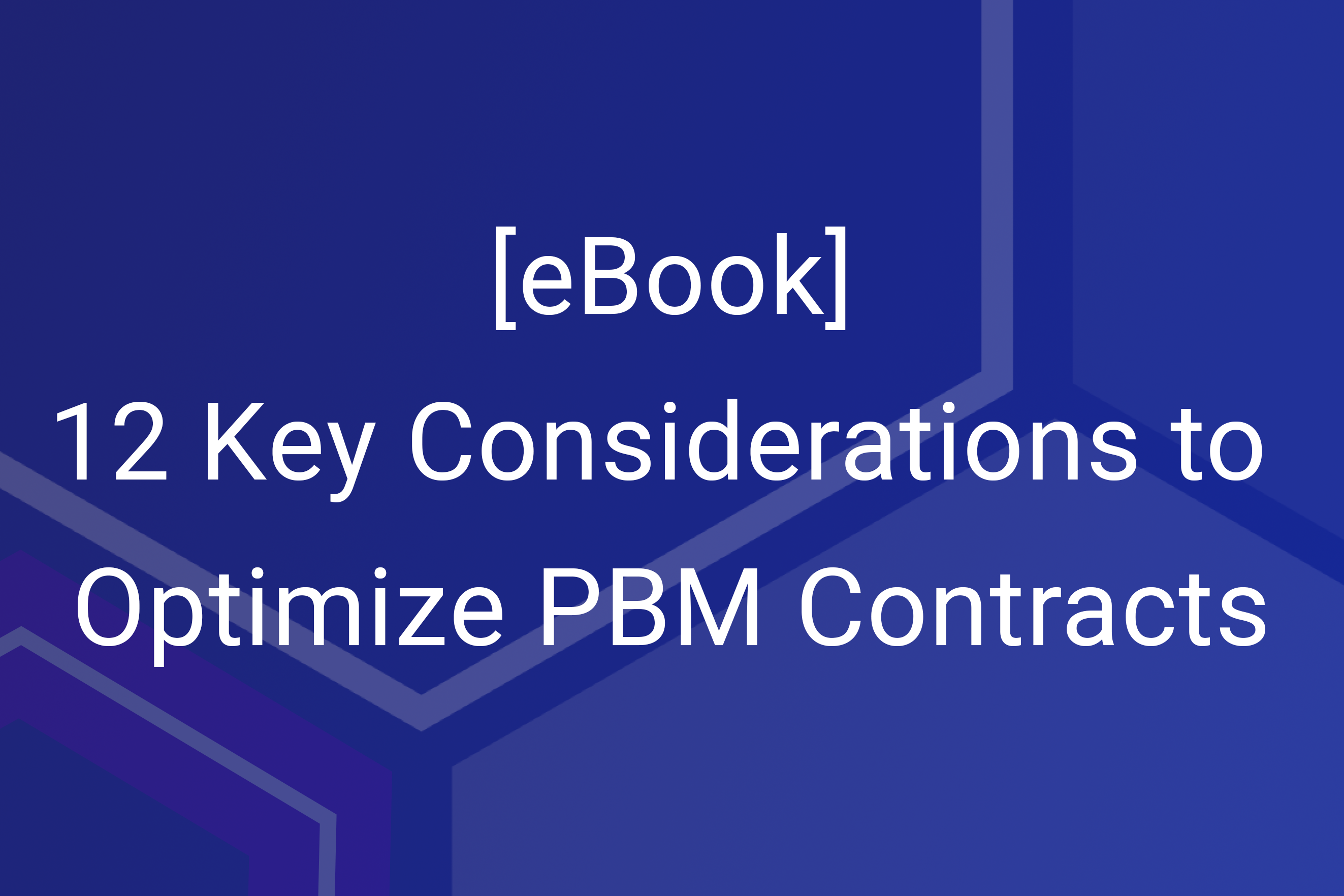As prescription drugs continue to get more expensive, many organizations are struggling to manage pharmacy benefit costs, especially for hyper-expensive specialty drugs. Plan sponsors know there are limits to cost shifting, as more than a quarter of patients say it is difficult to afford their prescription medications. Higher out-of-pockets costs increase the potential for prescription abandonment, non-adherence, and poor health outcomes. For these reasons, plan sponsors are exploring new strategies to manage specialty drug costs, including copay assistance programs.
Louise Shea, RPh, Senior Vice President of Product Strategy at Truveris and a long-time PBM veteran, reviewed some of these cost-saving strategies in a recorded Truveris webinar. Shea provided an objective overview of several copayment assistance programs — specifically, accumulator adjustment programs, copay maximizers, and alternative funding — along with their impact on stakeholders and considerations for implementing each.
What are copay assistance programs?
Traditional pharmaceutical manufacturer offer copay assistance programs are offered to insured patients to help them afford expensive prescription drugs by covering part or all of a member’s deductible and copay for certain medications.
Copay coupons and copay cards that dispense funds from the assistance program are not the same type of aid as need-based Patient Assistance Programs (PAPs). Whereas PAPs offer low-income individuals who are uninsured or underinsured access to free or low-cost prescription medication, copay coupons are, in essence, a marketing strategy. The manufacturer leverages these coupons to attract insured patients to their medication and circumvent formulary lists (since the copay card could render the medication cheap enough to eliminate the patient’s financial incentives to opt for less expensive options listed on the formulary).
What are copay accumulators and maximizers?
In reality, copay accumulators and maximizers are not conventional copay assistance programs, but rather a market reaction from PBMs to the copay assistance programs offered by pharmaceutical manufacturers. Both accumulators and maximizers are designed to extract the benefit dollars manufacturers make available through coupons and copay cards. And though they work in very different ways, “each helps reduce plan costs and have become the norm in pharmacy benefits in recent years,” said Shea. According to Drug Channels, more than 40% of plan sponsors had implemented one or both these programs by 2021.
- Accumulators exclude manufacturer copay-assistance dollars from a member’s deductibles or out-of-pocket limits, extending the amount of time before a member fulfills their out-of-pocket obligations. To the plan sponsor, the effect is in reverse proportion to richness of plan design (leaner benefits means greater savings). Adaptable across plan types, accumulators are typically applied to specialty medications, because of their high costs.
- Maximizers sometimes called variable copay programs, reclassify a subset of specialty medications as “non-essential”, removing the ACA requirements related to maximum out-of-pocket. These medications are assigned a percentage coinsurance within the benefit, but patients are always charged $0 for these drugs. This protects the member from a cost cliff, should the manufacturer benefit run out before the end of the year.
PBMs identify the available copay assistance and spread that across a patient’s benefit year to maximize the use of those available funds. Each PBM has its own unique maximizer program, but they all share the same goal of maximizing the value of copay assistance to benefit the employer, patient, and PBM alike.
Which copay assistance programs are most beneficial to a plan sponsor?
It depends on benefit design and the needs of the population. To illustrate how these programs work in practice, Shea applied each to a hypothetical scenario:
- Drug cost: $4,000 for a 30-day fill
- Manufacturer assistance: $10,000/year with a patient pay of $5/fill
- Member deductible and co-insurance: $1,200 and 20%, respectively
- Member out-of-pocket maximum: $5,000

During this webinar, you can see each stakeholder’s month-by-month dollar cost, as adjusted through both an accumulator and a maximizer.
Application of either program results in savings to the plan sponsor — in this scenario, 23% savings with the accumulator and 12% savings with the maximizer. In both programs, the full dollar value of the manufacturer benefit goes to the payer; without either program in place, more than half of those dollars remain unclaimed.
In this scenario, the most obvious difference between the programs is found in the members’ out-of-pocket costs. Under the accumulator, a “balloon payment” occurs mid-year when the manufacturer benefit runs out, at which time the costs of the medication begins to be charged directly to the member. Shea warned that if the member is not expecting this change, there is a risk of patient abandonment: “We’ve seen historically that when a copay gets above $250, members stop filling their prescriptions.”


Maximizers lower the adherence concern, because the patient pays $0 for the drug. Because of this, maximizers may save less for plan sponsors than accumulators, but the tradeoff may be lower associated costs for the member and potentially greater member adherence leading to better health outcomes.
Each PBM-sponsored maximizer program is unique in its operation and the medications it includes. Because it’s drug-specific (i.e., not spread across the benefit), a maximizer’s cumulative effect may be tricky to measure. Keep in mind that a member still has deductibles and out-of-pocket costs for other medications not subject to the maximizer.

How does alternative funding compare to these copay assistance strategies?
Alternative funding is another popular cost-saving copay assistance program. Alt funding programs shift costs away from the plan sponsor by seeking third-party dollars from manufacturers’ patient-assistance programs, charitable foundations, and not-for-profit organizations to finance drug costs.
Each alternative funding program works differently, but in general, high-cost drugs are carved out of the benefit, rendering a patient functionally uninsured for those drugs. The vendor then handles all aspects of payment and fulfillment of the prescription. Vendors have different payment arrangements with plan sponsors including a percent of savings charge or an administrative fee approach. By contracting with a separate company for the pharmacy portion of the benefit, as related to specific diseases or specialty treatments, employers can manage their pharmacy drug access in a more nuanced fashion.
“Evaluating these programs with a critical eye is important,” Shea stressed, noting that their myriad variables mean no guaranteed savings. Some key questions to consider include:
- Does the member meet the financial qualifications?
- Are funds available?
- Do you have new members coming into your population change the drug mix which could impact the drugs included and the value of the program?
- How would this work with your entire benefit?
How should plan sponsors select a cost-containment strategy?
Each of these copay assistance programs carry important cost considerations including regulatory and compliance issues, plan design, and potential financial impacts on both the plan sponsor and the member.
Shea stressed the importance of educating members about how a benefit program works. “Really, the bottom line is educating yourself and having the tools to educate your members, because they are a key player in these programs and in the process.” Consider the goals of your organization and the unique needs of your population. No program is one-size-fits all.
If all three programs have a common thread, it is this: they are complicated to implement. Plan sponsors should understand what these programs mean for their specific population, and leverage data, technology, and expertise to navigate decisions. Ongoing legal developments around copay assistance programs and specialty drug costs, such as the federal removal of the AMP Cap and prohibition of copay accumulators in several states, continue to shape the conversation as well.
View this Truveris webinar to learn more about mechanics of each program, their impact on stakeholders, and suggestions for implementation.
Truveris is a leading digital health company focused on delivering truth and clarity in pharmacy. Truveris’ proprietary technology, coupled with deep pharmacy expertise, helps to build a more efficient market that maximizes choice, accessibility and prescription drug affordability. Our solutions provide the insight and knowledge to help people lead healthier and more productive lives.







